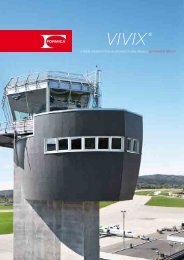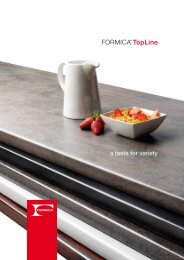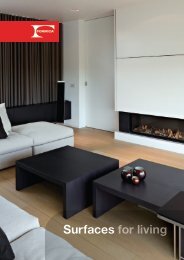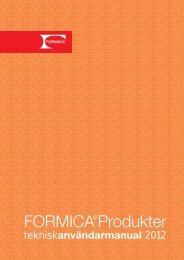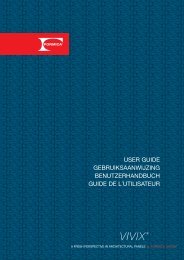Technical Information dispelling traditions - Formica
Technical Information dispelling traditions - Formica
Technical Information dispelling traditions - Formica
You also want an ePaper? Increase the reach of your titles
YUMPU automatically turns print PDFs into web optimized ePapers that Google loves.
formica_technical.qxd:formica_technical.qxd 28/11/08 16:01 Page 17Postforming 2 of 2Continuous process using PVAc adhesivesThese machines are favoured in the mass production kitchenfurniture industry because of the high degree of automation,and their ability to utilise adhesives which require no specialextraction facilities and present no fire hazard.The panels or worktops are first veneered in a flat bondingpress, with the laminate overhanging the profiled edges.The postforming machines are self contained units; forming,glueing and trimming in one pass.Continuous process using contact adhesivesThese machines are usually double sided and capable ofconsiderable width adjustment. The panel or worktop isfirst veneered by spraying both the laminate and core-board(including the profiled edges) with neoprene adhesive, andbonding them under pressure by passing the assemblythrough rubber covered nip rollers.During the postforming process the laminate is first heatedby passing through an infra-red heating zone to reach formingtemperature. The heat reactivates the adhesive so that whenthe laminate is formed and pressed home by the rollers, it willinstantly bond with the adhesive coating on the profilededges of the core-board.CovingThe internal (concave) bend of a worktop having an integral riseris usually achieved by milling away the core-board in the area ofthe bend, and then postforming the laminate over a heated metalformer. An MDF in-fill piece (heel-piece) is inserted and glued inposition after the laminate has been formed.1. ChipboardGood quality chipboard having a smooth and even surface finishis essential. It should be constructed to prevent tearing out of thechip particles during the edge profiling process and provide a fineeven surface with no voids. A brushing operation to remove looseparticles after machining the profile is advisable.2. MDFThe excellent machining qualities of MDF make it an idealsubstrate for producing smooth edge profiles.3. PlywoodMachining of the profile is more difficult with plywood as themultiple glue lines can produce unequal wear of cutter blades.Blades must be kept as sharp as possible and will benefit frombeing regularly cleaned and coated with a release agent to preventresin build-up.A post sanding operation followed by brushing is advisableafter machining.The machining direction should follow the grain of thesurface veneers.4. Solid nose-piecesWhere components are required to have a large external radius,the profile should be fashioned from built-up sections of MDFor chipboard and never from solid timber, which may shrinkand produce ripples on the surface of the laminate.Substrates for use in postformed componentsThe requirements for providing a good substrate for laminatesin general fabrication apply also in postforming. In addition,a substrate having good edge machining properties (producinga smooth clean finish with minimum break out) is required toprovide a smooth transition from the flat into the radius, andflawless adhesion over the curve with minimum show-through.<strong>Formica</strong> Limited, Coast Road, North Shields, Tyne & Wear NE29 8RE. Tel: 0191 259 3000. Fax: 0191 258 2719.<strong>Formica</strong> is a registered trade mark of <strong>Formica</strong> Corporation or its subsidiaries.<strong>Technical</strong> Services Department April 2004.16




